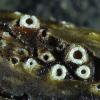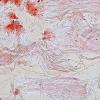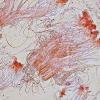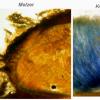
08-12-2025 17:37
 Lothar Krieglsteiner
Lothar Krieglsteiner
20.6.25, on branch of Abies infected and thickened

15-01-2026 15:55
 Lothar Krieglsteiner
Lothar Krieglsteiner
this one is especially interesting for me because

13-01-2026 07:28
 Danny Newman
Danny Newman
Chlorociboria glauca on indet. decorticate logThe

13-01-2026 08:43
 Danny Newman
Danny Newman
Tricladium varicosporioides on indet. decorticate

07-01-2026 22:22
 Danny Newman
Danny Newman
Tatraea sp. on indet. hardwood The Swag, Great Sm

13-01-2026 09:10
 Danny Newman
Danny Newman
Dasyscyphella chrysotexta on indet. decorticate ha

13-01-2026 10:13
 Danny Newman
Danny Newman
Cordieritidaceae sp. on indet. wood w/ Hypoxylon s
Stictis sp
Miguel Ăngel Ribes,
14-08-2008 23:39
 Sobre madera en bosque de laurisilva (Tenerife, Islas Canarias). Ascas octospĂłricas, aparentemente no amiloides. Esporas filiformes, muy largas, multiseptadas, formando un trenzado entre ellas cuando estĂĄn dentro del asca. ParĂĄfisis muy largas, delgadas, filiformes, con la punta bifurcada y flexuosa, que en agua se confunden fĂĄcilmente con las esporas, pero mĂĄs delgadas que las esporas. En la base de las ascas y las parĂĄfisis en masa hay una sustancia ligeramente amiloide, que a veces tambiĂŠn aparece en las puntas, y hace que algunas ascas parezca amiloides. Las medidas de las esporas son ligeramente mayores que las de las propias ascas, supongo que debido a que estĂĄn trenzadas dentro del asca y ocupan menos de largo.
Sobre madera en bosque de laurisilva (Tenerife, Islas Canarias). Ascas octospĂłricas, aparentemente no amiloides. Esporas filiformes, muy largas, multiseptadas, formando un trenzado entre ellas cuando estĂĄn dentro del asca. ParĂĄfisis muy largas, delgadas, filiformes, con la punta bifurcada y flexuosa, que en agua se confunden fĂĄcilmente con las esporas, pero mĂĄs delgadas que las esporas. En la base de las ascas y las parĂĄfisis en masa hay una sustancia ligeramente amiloide, que a veces tambiĂŠn aparece en las puntas, y hace que algunas ascas parezca amiloides. Las medidas de las esporas son ligeramente mayores que las de las propias ascas, supongo que debido a que estĂĄn trenzadas dentro del asca y ocupan menos de largo.On wood at laurisilva forest (Tenerife, Canary Island). Asci 8 spores, seemingly not amiloides. Filiform and very long spores, multiseptated, coiled when they are inside the asci. Very long, thin, filiform paraphysis, with forked and flexuous top, in water get confused easily with the spores, but thinner than the spores. At the base of the ascas and the paraphysis there there is a substance lightly amiloide, that sometimes also appears in the tops, and does that some ascas seems amiloid. The measures of the spores are lightly major that the ascai, I suppose that due to the fact that they are coiled inside the asci and have a shorter length.
Sporal measures (400x, water and y congo red, fresh material)
207.3 [288.7 ; 334.2] 415.5 x 1.1 [2.2 ; 2.9] 4
Q = 63.6 [114.3 ; 143.6] 194.3 ; N = 21 ; C = 95%
Me = 311.43 x 2.57 ; Qe = 128.95
Asci measures (400x, water and y congo red, fresh material)
248.5 [291.8 ; 327] 370.4 x 4.3 [7.1 ; 9.3] 12
N = 12 ; C = 95%; Me = 309.44 x 8.17
Miguel Ăngel Ribes,
14-08-2008 23:53
Miguel Ăngel Ribes,
15-08-2008 00:07
Miguel Ăngel Ribes,
15-08-2008 00:09
Miguel Ăngel Ribes,
15-08-2008 00:11
Miguel Ăngel Ribes,
15-08-2008 00:24

Re:Stictis sp
Siguiendo las claves de Martha A. Sherwood, en Mycotaxon 5(1): 1-277, "The Ostropalean fungi", llego a varias especies que no concuerdan:
* S. sarothamni: con ascas y esporas mĂĄs pequeĂąas y sobre Sarothamnus.
* S. carpenteriana: con borde lacerado, ascas y esporas mĂĄs pequeĂąas.
* S. viticola: con poro ancho, orbicular, margen muy delgado gris pruinoso, parĂĄfisis no bifurcadas, ascas y esporas mĂĄs grandes.
* S. bicolor: margen gris oscuro, parĂĄfisis no ramificadas.
* S. oculiformis: margen oscuro, ascas y esporas mĂĄs pequeĂąas.
* S. korfii: margen gris pĂĄlido, parĂĄfisis no ramificadas, ascas y esporas mĂĄs pequeĂąas.
Sin embargo, mirando las descripciones una por una, con la que mĂĄs coincide es con S. prominens: margen prominente, blanco, entero y pruinoso, parĂĄfisis filiformes, ramificadas y circinadas apicalmente??, I+ Ăł I-, dependiendo de la edad, ascas de 220-300 x 6(-8), esporas de 220-300 x 2-2,25, septadas.
Muchas gracias por vuestra ayuda
According to Martha A. Sherwood's keys, in Mycotaxon 5 (1): 1-277, " The Ostropalean fungi ", I arrive to several species, but no one is completley Ok:
* S. sarothamni: with smaller asci and spores and growing on Sarothamnus.
* S. carpenteriana: with spoilt edge, smaller asci and spores.
* S. viticola:: with broad pore, orbicular, margin very thin and gray pruinose, paraphysis not bifurcated, bigger asci and spores.
* S.bicolor: dark gray margin, paraphysis not branched.
* S. oculiformis: dark margin, smaller asci and spores.
* S. korfii: pale gray margin, paraphysis not branched, smaller asci and spores.
Nevertheless, looking at the descriptions one by one, it fits better with S. prominens: prominent margin, white, entire and pruinose, paraphysis filiform, branched and circinal at the apex??, I + Ăł I-, depending on the age, asci 220-300 x 6 (-8), spores 220-300 x 2-2,25, septated.
Thank you very much
* S. sarothamni: con ascas y esporas mĂĄs pequeĂąas y sobre Sarothamnus.
* S. carpenteriana: con borde lacerado, ascas y esporas mĂĄs pequeĂąas.
* S. viticola: con poro ancho, orbicular, margen muy delgado gris pruinoso, parĂĄfisis no bifurcadas, ascas y esporas mĂĄs grandes.
* S. bicolor: margen gris oscuro, parĂĄfisis no ramificadas.
* S. oculiformis: margen oscuro, ascas y esporas mĂĄs pequeĂąas.
* S. korfii: margen gris pĂĄlido, parĂĄfisis no ramificadas, ascas y esporas mĂĄs pequeĂąas.
Sin embargo, mirando las descripciones una por una, con la que mĂĄs coincide es con S. prominens: margen prominente, blanco, entero y pruinoso, parĂĄfisis filiformes, ramificadas y circinadas apicalmente??, I+ Ăł I-, dependiendo de la edad, ascas de 220-300 x 6(-8), esporas de 220-300 x 2-2,25, septadas.
Muchas gracias por vuestra ayuda
According to Martha A. Sherwood's keys, in Mycotaxon 5 (1): 1-277, " The Ostropalean fungi ", I arrive to several species, but no one is completley Ok:
* S. sarothamni: with smaller asci and spores and growing on Sarothamnus.
* S. carpenteriana: with spoilt edge, smaller asci and spores.
* S. viticola:: with broad pore, orbicular, margin very thin and gray pruinose, paraphysis not bifurcated, bigger asci and spores.
* S.bicolor: dark gray margin, paraphysis not branched.
* S. oculiformis: dark margin, smaller asci and spores.
* S. korfii: pale gray margin, paraphysis not branched, smaller asci and spores.
Nevertheless, looking at the descriptions one by one, it fits better with S. prominens: prominent margin, white, entire and pruinose, paraphysis filiform, branched and circinal at the apex??, I + Ăł I-, depending on the age, asci 220-300 x 6 (-8), spores 220-300 x 2-2,25, septated.
Thank you very much
Hans-Otto Baral,
15-08-2008 00:30

Re:Stictis sp
Dear Miguel
identifying Stictis is very difficult. Despite the work of Sherwood I am quite unable to name most of my collections of Ostropales. I think it is necessary to make vital taxonomy in this group as in any other. The spores are not only filiform but the size of the individual cells is important and also the guttulation of the living spore cells (multigutulate or almost egutulate depending on the species).
The spores are usually straight inside the living asci but get coiled due to ascus shrinkage.
Besides it is important to use Lugol, a fact that Sherwood was unaware of. I attach here an example how Melzer gives no reaction but when pretreated with KOH gives intensely blue. Sherwood did not know that. Your Stictis will probably not react such intense after KOH, but I suppose it will. In IKI without KOH one gets a distinctly red reaction.
Zotto
identifying Stictis is very difficult. Despite the work of Sherwood I am quite unable to name most of my collections of Ostropales. I think it is necessary to make vital taxonomy in this group as in any other. The spores are not only filiform but the size of the individual cells is important and also the guttulation of the living spore cells (multigutulate or almost egutulate depending on the species).
The spores are usually straight inside the living asci but get coiled due to ascus shrinkage.
Besides it is important to use Lugol, a fact that Sherwood was unaware of. I attach here an example how Melzer gives no reaction but when pretreated with KOH gives intensely blue. Sherwood did not know that. Your Stictis will probably not react such intense after KOH, but I suppose it will. In IKI without KOH one gets a distinctly red reaction.
Zotto
Miguel Ăngel Ribes,
15-08-2008 01:01

Re:Stictis sp
Hi Zotto, your answer have been really quick.
The first bibliography I checked with this fungi was your DVD and I saw you have no name in several Stictis. If you are unable to name someones, so I considered myself a completly useless to give it an aproximately name.
Next time than I collect a Stictis I will try to do my job better than now. It is really dificult this small fungi.
Thank you.
The first bibliography I checked with this fungi was your DVD and I saw you have no name in several Stictis. If you are unable to name someones, so I considered myself a completly useless to give it an aproximately name.
Next time than I collect a Stictis I will try to do my job better than now. It is really dificult this small fungi.
Thank you.
Hans-Otto Baral,
15-08-2008 15:15

Re:Stictis sp
yes, Stictis is difficult and I hate the genus. But I learnd that they are interesting, and that they really have characters. But the methods may strongly influence the result and make comparison incompatible. For example, I know a species of ?Odontotrema from the semideserts which seems to have almost straight spores about 25 x 3 Âľm. If you put the mount in KOH, the spores become strongly helicoid! First I thought I have two different species, because I could not imagine such severe influence of KOH.
Good luck!
Zotto
Good luck!
Zotto
Miguel Ăngel Ribes,
16-08-2008 12:42

Re:Stictis sp
Really amazing. At hollidays I am going to read slowly your vital taxonomy, I have only take a glance now. But in my document titled "Vital vs. herbarium taxonomy, 1992, Mycotaxon.DOC" I can not see the photos. The PowerPoint presentation titled "Vital vs. herbarium taxonomy, 2005.ppt" is Ok.
Thaks again.
Thaks again.
Hans-Otto Baral,
24-08-2008 23:06

Re:Stictis sp
There are no photos in that doc file, actually. Or perhaps only some of them. I have a file in which about half of the images are missing. Otherwise I would send it, sorry.
Zotto
Zotto
Miguel Ăngel Ribes,
25-08-2008 10:57

Re:Stictis sp
Thanks Zotto, don't worry.








